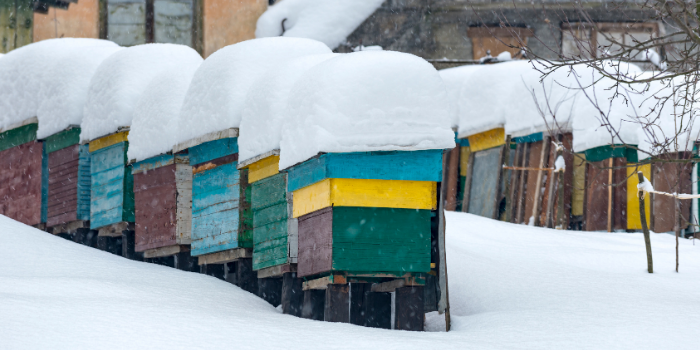
The Beekeeper's Guide to Winter Bee Activities
When winter temperatures plummet, bees have to work hard to keep temperatures inside the hive warm enough. When outside temperatures drop to 64°F, the bees begin to form a loose cluster to provide and maintain warmth.
Heater Bees
Some bees take on the job of “heater bees,” focusing their efforts on heating the cluster. Heater bees perform this task by decoupling their wings from their wing muscles and using these muscles to vibrate and generate heat without actually having to move their wings. They can also vibrate their abdomens. These actions heat up their bodies to approximately 111° F (16 degrees hotter than normal). The cluster’s center is the warmest and temps begin to drop moving out from there. At the center of the cluster, you’ll find the queen and a small amount of brood.
In the center of the cluster, the bees can move about freely, caring for the queen and any brood. In the dead of winter, brood may be almost non-existent. As the days lengthen, however, brood-rearing activities increase. When no brood is present in the hive, the internal cluster temperature may be allowed to drop as low as 68°F, thereby conserving energy. When brood is present, the temperature is kept between 92-95°F.
Density within the cluster itself varies. As we’ve already stated, inside the innermost area of the cluster, the bees are able to move about freely. The outermost layers become denser to retain heat in the center. A cluster spans multiple frames inside the hive.
The temperature inside the cluster is regulated by the expansion and contraction of the cluster itself. If the brood area becomes too warm, the bees expand the cluster to allow for increased airflow. If the brood area becomes too cold, the cluster contracts, thereby impeding airflow. If enough bees are not present in the hive to provide for and maintain heating needs, the hive will die.
Bees on the outer edges of the cluster become so cold they appear motionless and dead. Warm bees from inside the cluster take positions outside these cold, motionless bees, forcing them towards the center where they are warmed and revived.
The cluster moves around as a unit within the hive, “grazing” on honey stores. If the cluster loses contact with an area of stored honey, the bees may starve.
The Hive's Upward Move
Given the opportunity, the hive will move upwards because warm air rises, and they gravitate towards the heat. In fact, if food stores are present to the right, the left, above and below the bees, the cluster will always move up first because temperatures are the warmest above the cluster. This is why some beekeepers provide their bees with an upper entrance during the cold winter months. On those days when temperatures increase to 50°F, the entrance makes it easy for bees to undergo cleansing flights, allowing the bees to remain warm until exiting the hive. When they return from their quick flight, they are met with warm air.
Yes, some warm air does escape through the top entrance, but bees that make cleansing flights (which is encouraged by the top entrance) are less likely to develop dysentery. If you have occasionally warm days in the winter, consider adding an upper entrance and an upper entrance hive protector to your hive to give bees easy access for cleansing flights.
Because the cluster is generally on the move upward, it may even straddle two brood boxes. When beekeepers reverse brood boxes in the spring (a common practice), the cluster may become split and there may not be enough bees to keep both brood areas warm. When this occurs, the hive can die.
This is what your bees are doing during January. Join us next time to discover what you should be doing. In the meantime, keep a book about bees and/or beekeeping handy for snow days and bedtime reading.
General Question About Beekeeping in Winter
1. Why do bees form a cluster in the winter?
Bees form a cluster in the winter to conserve heat and maintain a stable temperature within the hive. This clustering behavior allows them to keep the queen and any brood warm, ensuring the survival of the colony during cold months. The bees vibrate their wing muscles to generate heat, which is concentrated in the center of the cluster.
2. How can I help my bees survive the winter?
To help your bees survive the winter, ensure the hive is well-insulated and consider adding an upper entrance for ventilation and cleansing flights. Make sure there are adequate honey stores for the bees to consume during the winter months. Monitor the hive periodically to ensure the bees have enough resources and are not exposed to excessive cold or moisture.



Leave a comment